Choosing from an Optimal Number of Options Makes Curry and Tea More Palatable
Abstract
1. Introduction
2. Experiment 1
2.1. Overview
2.2. Materials and Methods
2.2.1. Participants
2.2.2. Stimuli
2.2.3. Procedure
2.2.4. Data Analysis
2.3. Results
2.4. Discussion
3. Experiment 2
3.1. Overview
3.2. Materials and Methods
3.2.1. Participants
3.2.2. Stimuli
3.2.3. Procedure
3.2.4. Data Analysis
3.3. Results
3.4. Discussion
4. General Discussion
5. Conclusions
Author Contributions
Funding
Acknowledgments
Conflicts of Interest
References
- Kamenetzky, J. Contrast and convergence effects in rating of foods. J. Appl. Psychol. 1959, 43, 47–52. [Google Scholar]
- Sakai, N.; Kataoka, F.; Imada, S. Contrast effect in evaluating palatability of beverages. Percept. Mot. Skills 2001, 93, 829–842. [Google Scholar] [CrossRef] [PubMed]
- Becker, L.; van Rompay, T.J.L.; Schifferstein, H.N.J.; Galetzka, M. Tough package, strong taste: The influence of packaging design on taste impressions and product evaluations. Food Qual. Pref. 2011, 22, 17–23. [Google Scholar] [CrossRef]
- Mielby, L.A.; Wang, Q.J.; Jensen, S.; Bertelsen, A.S.; Kidmose, U.; Spence, C.; Byrne, D.V. See, feel, taste: The influence of receptacle colour and weight on the evaluation of flavoured carbonated beverages. Foods 2018, 7, 119. [Google Scholar] [CrossRef]
- Fiegel, A.; Meullenet, J.-F.; Harrington, R.J.; Humble, R.; Seo, H.-S. Background music genre can modulate flavor pleasantness and overall impression of food stimuli. Appetite 2014, 76, 144–152. [Google Scholar] [CrossRef] [PubMed]
- Wang, Q.J.; Keller, S.; Spence, C. Sounds spicy: Enhancing the evaluation of piquancy by means of a customised crossmodally congruent soundtrack. Food Qual. Pref. 2017, 58, 1–9. [Google Scholar] [CrossRef]
- Plassmann, H.; O’Doherty, J.; Shiv, B.; Rangel, A. Marketing actions can modulate neural representations of experienced pleasantness. Proc. Natl. Acad. Sci. USA 2008, 105, 1050–1054. [Google Scholar] [CrossRef] [PubMed]
- Allison, R.I.; Uhl, K.P. Influence of beer brand identification on taste perception. J. Mark. Res. 1964, 1, 36–39. [Google Scholar] [CrossRef]
- McClure, S.M.; Li, J.; Tomlin, D.; Cypert, K.S.; Montague, L.M.; Montague, P.R. Neural correlates of behavioral preference for culturally familiar drinks. Neuron 2004, 44, 379–387. [Google Scholar]
- Onuma, T.; Fuchimoto, J.; Sakai, N. Brand categorization and hedonic transfer: Negative evaluations of a beverage transfers to a novel beverage from the same brand. Tohoku Psychol. Folia 2013, 72, 46–62. [Google Scholar]
- Prescott, J. Chemosensory learning and flavor: Perception, preference and intake. Physiol. Behav. 2012, 107, 553–559. [Google Scholar] [CrossRef]
- Stevenson, R.J. The Psychology of Flavor; Oxford University Press: Oxford, UK, 2009. [Google Scholar]
- Botti, S.; Iyengar, S.S. The psychological pleasure and pain of choosing: When people prefer choosing at the cost of subsequent outcome satisfaction. J. Pers. Soc. Psychol. 2004, 87, 312–326. [Google Scholar] [CrossRef]
- Dember, W.N.; Galinsky, T.L.; Warm, J.S. The role of choice in vigilance performance. Bull. Psychon. Soc. 1992, 30, 201–204. [Google Scholar] [CrossRef]
- Iyengar, S.S.; Lepper, M.R. When choice is demotivating: Can one desire too much of a good thing? J. Pers. Soc. Psychol. 2000, 79, 995–1006. [Google Scholar] [CrossRef]
- Zuckerman, M.; Porac, J.; Lathin, D.; Smith, R.; Deci, E.L. On the importance of self-determination for intrinsically motivated behavior. Pers. Soc. Psychol. Bull. 1978, 4, 443–446. [Google Scholar] [CrossRef]
- Cardello, A.V.; Sawyer, F.M. Effects of disconfirmed consumer expectations on food acceptability. J. Sens. Stud. 1992, 7, 253–277. [Google Scholar] [CrossRef]
- Deliza, R.; MacFie, H.J.H. The generation of sensory expectation by external cues and effect on sensory perception and hedonic ratings: A review. J. Sens. Stud. 1996, 11, 103–128. [Google Scholar] [CrossRef]
- Lee, L.; Frederick, S.; Ariely, D. Try it, you’ll like it: The influence of expectation, consumption, and revelation on preferences for beer. Psychol. Sci. 2006, 17, 1054–1058. [Google Scholar] [CrossRef]
- Hafner, R.J.; White, M.P.; Handley, S.J. The Goldilocks placebo effect: Placebo effects are stronger when people select a treatment from an optimal number of choices. Am. J. Psychol. 2018, 131, 175–184. [Google Scholar] [CrossRef]
- Mogilner, C.; Rudnick, T.; Iyengar, S.S. The mere categorization effect: How the presence of categories increases choosers’ perceptions of assortment variety and outcome satisfaction. J. Consum. Res. 2008, 35, 202–215. [Google Scholar] [CrossRef]
- Reutskaja, E.; Hogarth, R.M. Satisfaction in choice as a function of the number of alternatives: “When goods satiate”. Psychol. Mark. 2009, 26, 197–203. [Google Scholar] [CrossRef]
- Shah, A.M.; Wolford, G. Buying behavior as a function of parametric variation of number of choices. Psychol. Sci. 2007, 18, 369–370. [Google Scholar] [CrossRef]
- Kahn, B.; Wansink, B. The influence of assortment structure on perceived variety and consumption quantities. J. Consum. Res. 2004, 30, 519–533. [Google Scholar] [CrossRef]
- Deci, E.L.; Eghrari, H.; Patrick, B.C.; Leone, D.R. Facilitating internalization: The self-determination theory perspective. J. Pers. 1994, 62, 119–142. [Google Scholar] [CrossRef] [PubMed]
- Miller, G. The magical number seven, plus or minus two: Some limits on our capacity for information processing. Psychol. Rev. 1956, 63, 81–97. [Google Scholar] [CrossRef] [PubMed]
- Chernev, A. When more is less and less is more: The role of ideal point availability and assortment in consumer choice. J. Consum. Res. 2003, 30, 170–183. [Google Scholar] [CrossRef]
- Chernev, A.; Bockenholt, U.; Goodman, J. Choice overload: A conceptual review and meta-analysis. J. Consum. Psychol. 2015, 25, 333–358. [Google Scholar] [CrossRef]
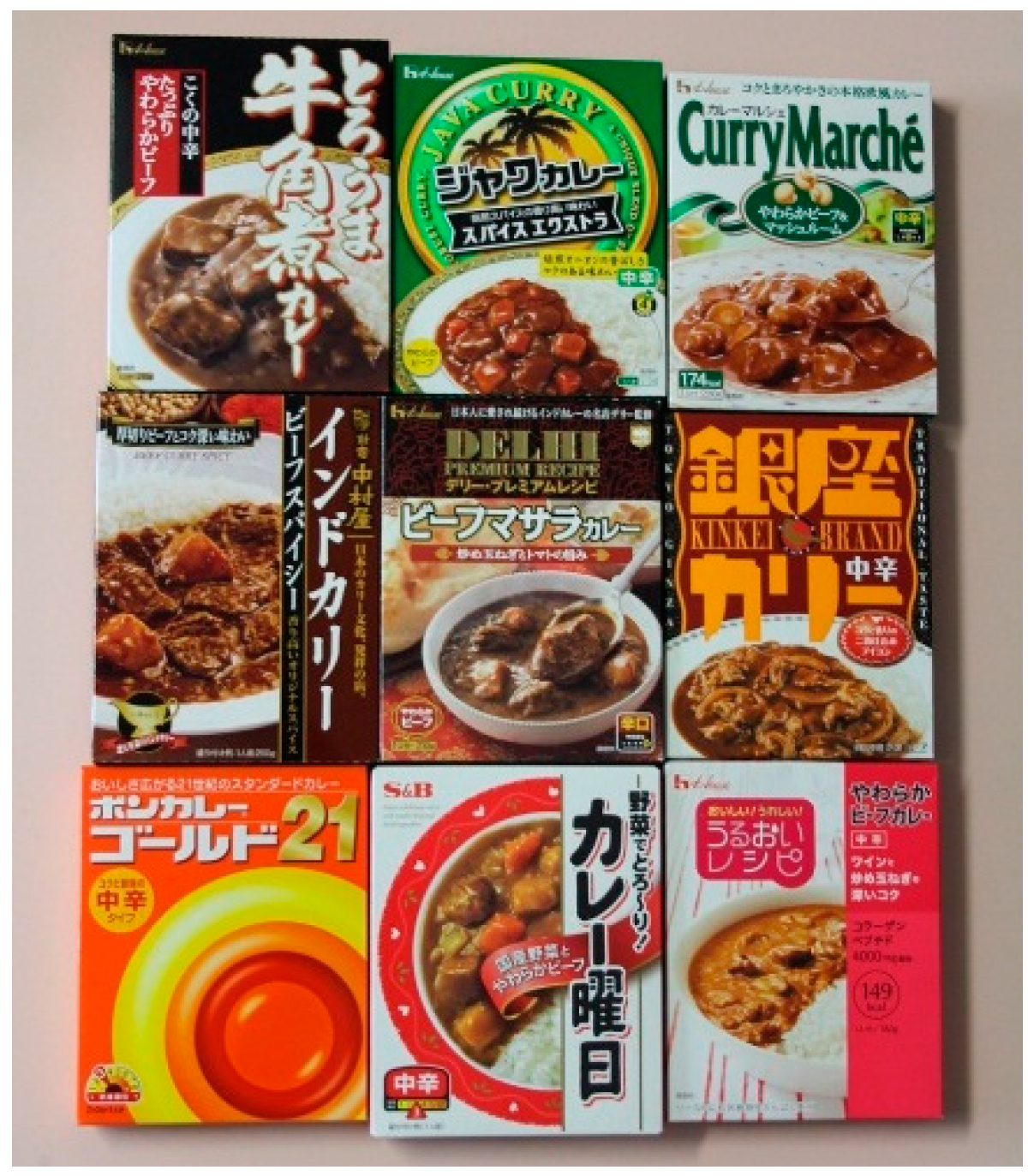
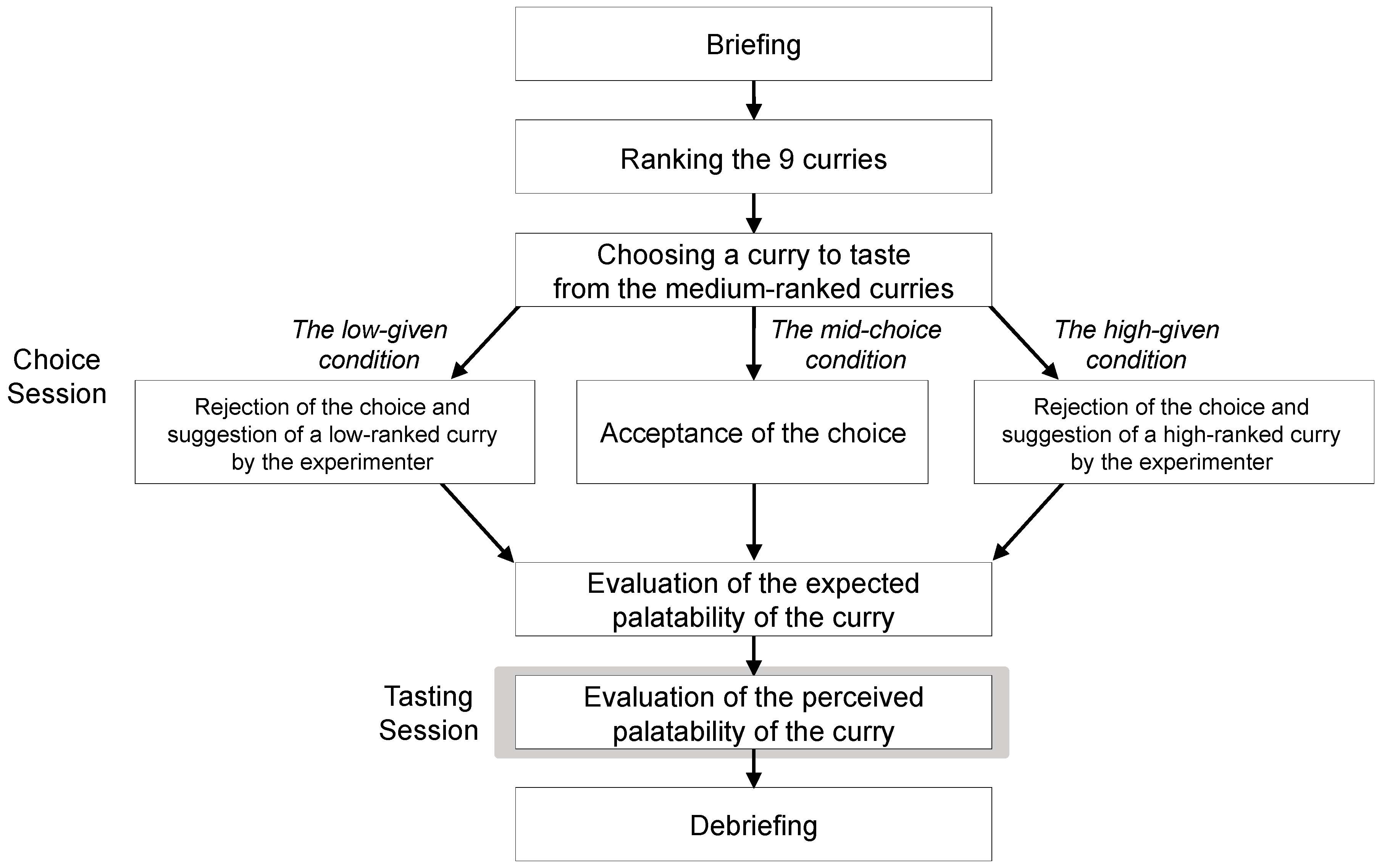


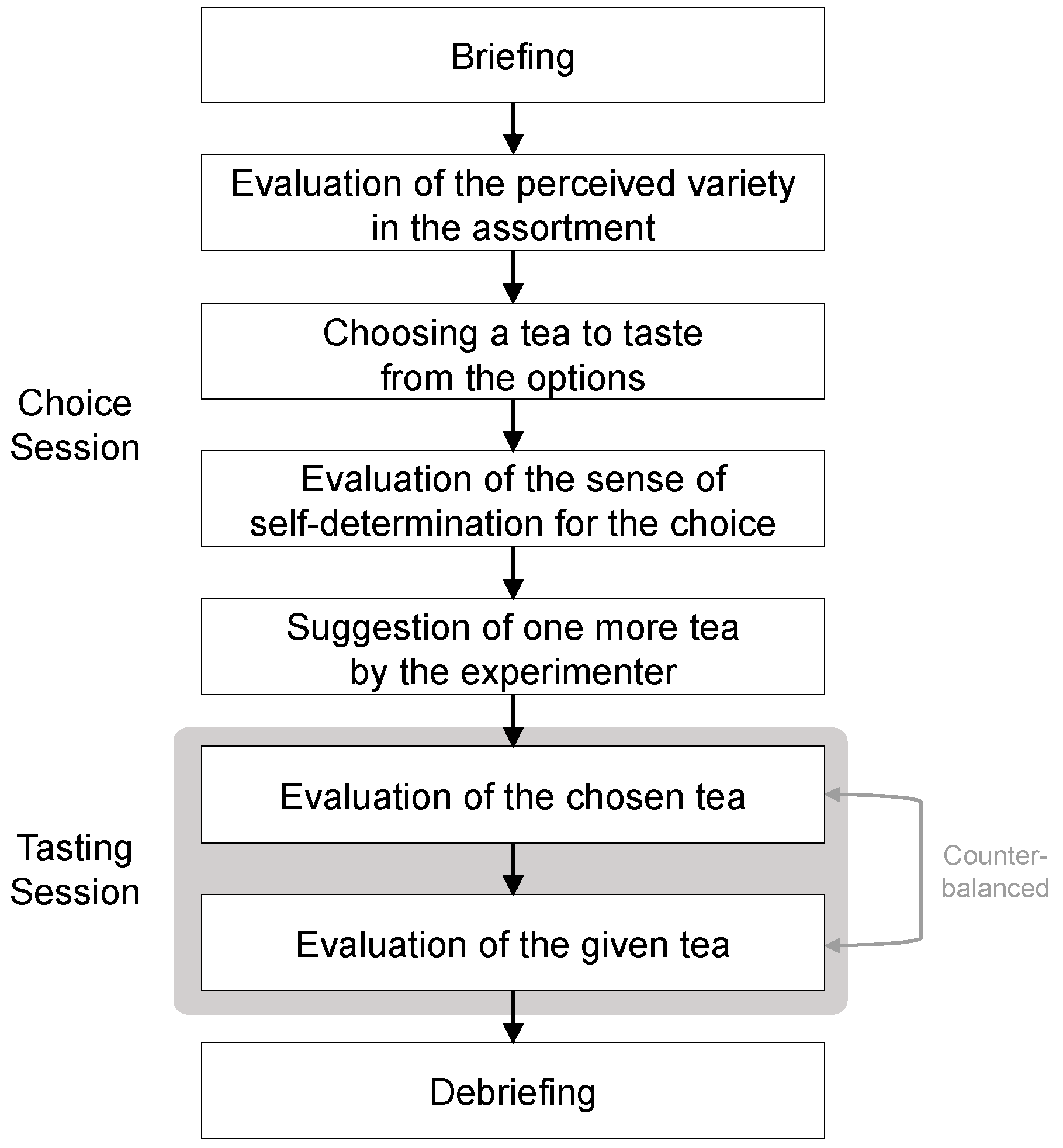
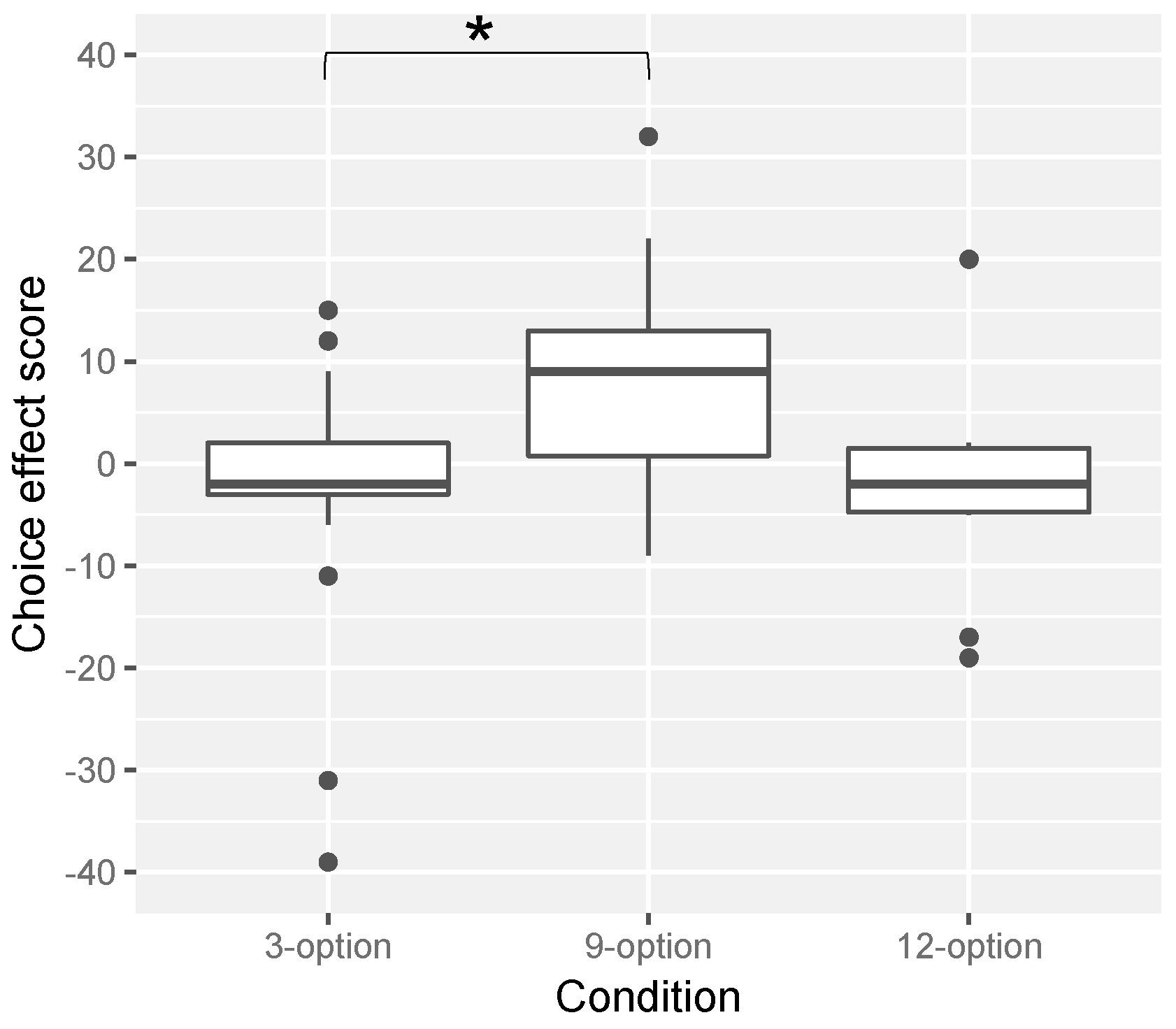
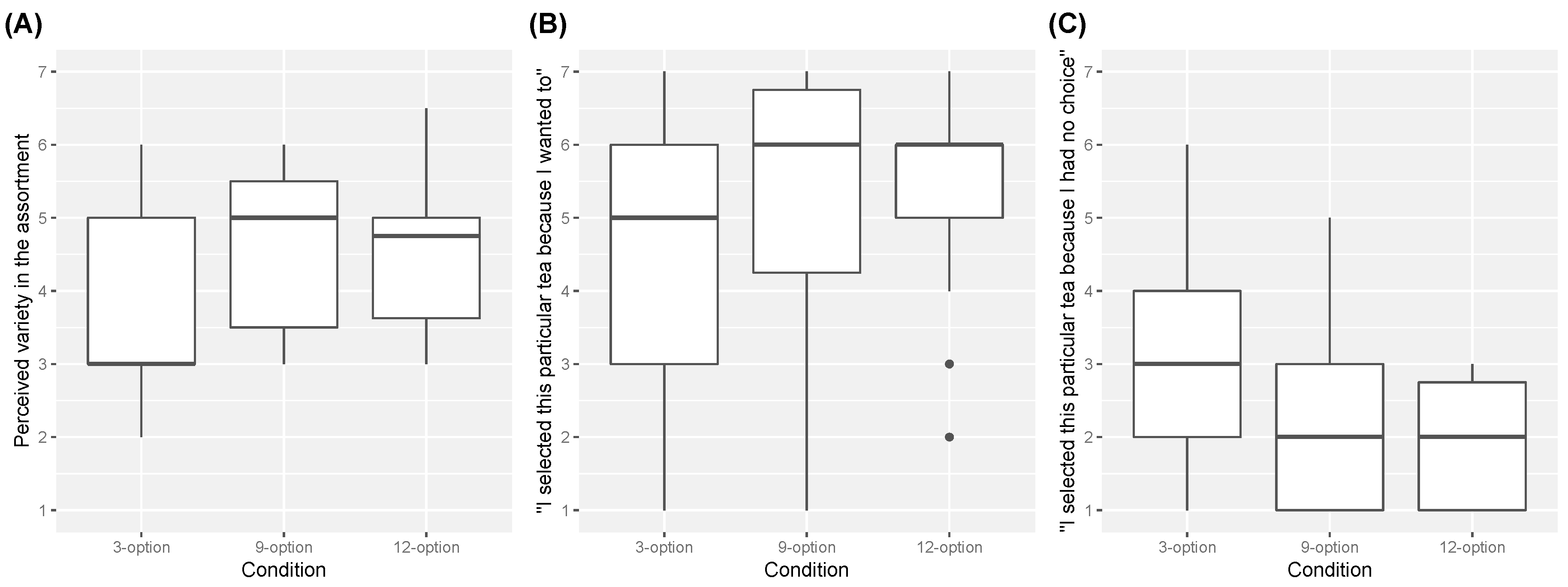
| Global | The Low-Given | The Mid-Choice | The High-Given |
|---|---|---|---|
| 0.01 (p = 0.95) | 0.13 (p = 0.71) | −0.28 (p = 0.43) | −0.30 (p = 0.40) |
© 2019 by the authors. Licensee MDPI, Basel, Switzerland. This article is an open access article distributed under the terms and conditions of the Creative Commons Attribution (CC BY) license (http://creativecommons.org/licenses/by/4.0/).
Share and Cite
Onuma, T.; Sakai, N. Choosing from an Optimal Number of Options Makes Curry and Tea More Palatable. Foods 2019, 8, 145. https://doi.org/10.3390/foods8050145
Onuma T, Sakai N. Choosing from an Optimal Number of Options Makes Curry and Tea More Palatable. Foods. 2019; 8(5):145. https://doi.org/10.3390/foods8050145
Chicago/Turabian StyleOnuma, Takuya, and Nobuyuki Sakai. 2019. "Choosing from an Optimal Number of Options Makes Curry and Tea More Palatable" Foods 8, no. 5: 145. https://doi.org/10.3390/foods8050145
APA StyleOnuma, T., & Sakai, N. (2019). Choosing from an Optimal Number of Options Makes Curry and Tea More Palatable. Foods, 8(5), 145. https://doi.org/10.3390/foods8050145






